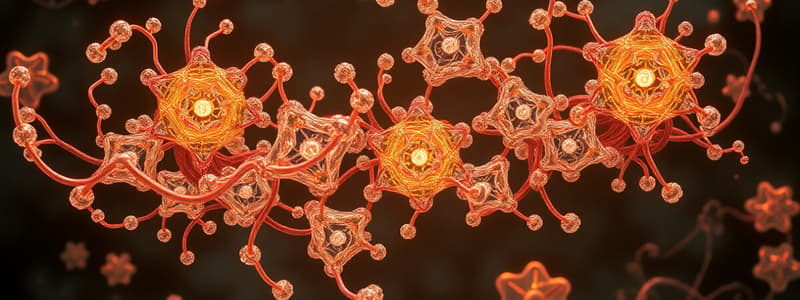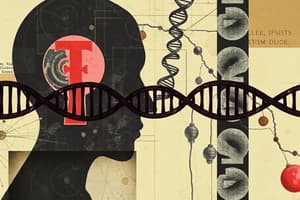Podcast
Questions and Answers
What primarily determines the host range of a plasmid?
What primarily determines the host range of a plasmid?
- The genes encoded by the plasmid
- The ori region of the plasmid (correct)
- The method of transformation
- The size of the plasmid
Which type of plasmids is likely to replicate in most Gram-negative bacteria?
Which type of plasmids is likely to replicate in most Gram-negative bacteria?
- RP4 plasmids (correct)
- RSF1010 plasmids
- Col E1 plasmids
- Staphylococcus aureus plasmids
What is the desirable size for a cloning vector plasmid?
What is the desirable size for a cloning vector plasmid?
- Less than 1 kb
- Less than 50 kb
- Less than 5 kb
- Less than 10 kb (correct)
What is the term for the number of plasmid molecules in a single bacterial cell?
What is the term for the number of plasmid molecules in a single bacterial cell?
Promiscuous plasmids like RSF1010 are characterized by their ability to:
Promiscuous plasmids like RSF1010 are characterized by their ability to:
Which feature is crucial for plasmids with a broad host range to function effectively?
Which feature is crucial for plasmids with a broad host range to function effectively?
What is a common misconception about plasmid size in cloning?
What is a common misconception about plasmid size in cloning?
Which feature do most plasmids with a broad host range have?
Which feature do most plasmids with a broad host range have?
What is a significant drawback of large size plasmids?
What is a significant drawback of large size plasmids?
Which of the following is NOT a desirable property of an ideal cloning vector?
Which of the following is NOT a desirable property of an ideal cloning vector?
What advantage do low molecular weight plasmids have over larger ones?
What advantage do low molecular weight plasmids have over larger ones?
What do R plasmids primarily carry?
What do R plasmids primarily carry?
Why are multiple cloning sites (MCS) beneficial in plasmids?
Why are multiple cloning sites (MCS) beneficial in plasmids?
Which type of plasmid is known specifically for facilitating conjugal transfer?
Which type of plasmid is known specifically for facilitating conjugal transfer?
What is a primary feature of plasmids that enables the isolation of cloned genes?
What is a primary feature of plasmids that enables the isolation of cloned genes?
Which type of plasmid is particularly important in clinical microbiology for its resistance properties?
Which type of plasmid is particularly important in clinical microbiology for its resistance properties?
Which type of plasmid allows the host bacterium to metabolize unusual molecules?
Which type of plasmid allows the host bacterium to metabolize unusual molecules?
What is the main function of col plasmids?
What is the main function of col plasmids?
Which eukaryotic plasmid is best characterized?
Which eukaryotic plasmid is best characterized?
What is the structure of bacteriophages primarily composed of?
What is the structure of bacteriophages primarily composed of?
What initiates the phage infection cycle?
What initiates the phage infection cycle?
What characteristic is NOT associated with plasmids in higher organisms?
What characteristic is NOT associated with plasmids in higher organisms?
Which of the following is an example of a virulence plasmid?
Which of the following is an example of a virulence plasmid?
Which statement about bacteriophage structure is true?
Which statement about bacteriophage structure is true?
What is the primary function of the additional DNA pieces in pGEM3Z?
What is the primary function of the additional DNA pieces in pGEM3Z?
Which RNA polymerases are recognized by the promoters in pGEM3Z?
Which RNA polymerases are recognized by the promoters in pGEM3Z?
What advantage do T7 and SP6 RNA polymerases offer in in vitro transcription?
What advantage do T7 and SP6 RNA polymerases offer in in vitro transcription?
What is the function of the lacZ′ gene found in pGEM3Z?
What is the function of the lacZ′ gene found in pGEM3Z?
What occurs when a recombinant pGEM3Z molecule is mixed with purified RNA polymerase?
What occurs when a recombinant pGEM3Z molecule is mixed with purified RNA polymerase?
How does the cloning vector pGEM3Z differ from traditional pUC vectors?
How does the cloning vector pGEM3Z differ from traditional pUC vectors?
What is a potential use for RNA produced from in vitro transcription using pGEM3Z?
What is a potential use for RNA produced from in vitro transcription using pGEM3Z?
What feature of the pGEM3Z vector facilitates the introduction of new DNA?
What feature of the pGEM3Z vector facilitates the introduction of new DNA?
What color do colonies appear when β-galactosidase is functional and reacts with X-gal?
What color do colonies appear when β-galactosidase is functional and reacts with X-gal?
What is the result when an insert disrupts the reading frame of the Lac Z gene?
What is the result when an insert disrupts the reading frame of the Lac Z gene?
What is a limitation of the blue-white screening procedure?
What is a limitation of the blue-white screening procedure?
Which statement best describes the role of the multiple cloning site (MCS) in the Lac Z gene?
Which statement best describes the role of the multiple cloning site (MCS) in the Lac Z gene?
What might cause ambiguous light blue colonies during the blue-white screening?
What might cause ambiguous light blue colonies during the blue-white screening?
What provides flexibility in cloning DNA fragments into pUC vectors?
What provides flexibility in cloning DNA fragments into pUC vectors?
How can cloned DNA from pUC vectors be directly obtained as single-stranded DNA?
How can cloned DNA from pUC vectors be directly obtained as single-stranded DNA?
What is a key function of IPTG in the blue-white screening process?
What is a key function of IPTG in the blue-white screening process?
Flashcards are hidden until you start studying
Study Notes
### Plasmids and Cloning Vectors
- Plasmids are extrachromosomal, circular DNA molecules found in bacteria, and certain other organisms.
- They can replicate independently of the bacterial chromosome.
- Plasmids are an essential tool in molecular biology, utilized for cloning and manipulating DNA.
### Host Range of Plasmids
- The host range of a plasmid refers to the range of bacterial species it can replicate in.
- Plasmids with origins of replication (ori) derived from ColE1 have a restricted host range, replicating only in enteric bacteria like E.coli and Salmonella.
- Promiscuous plasmids, like RP4 and RSF1010, exhibit broad host ranges, replicating in a wider variety of Gram-negative bacteria.
- RSF1010 can also be transformed into Gram-positive bacteria, showcasing broader compatibility.
- Plasmids with broad host ranges encode the necessary proteins for replication and possess promoters and ribosome binding sites that function in diverse bacterial families.
### Size and Copy Number
- The size of plasmids varies significantly from 1 kb to over 250 kb.
- For cloning applications, plasmids less than 10 kb are preferred due to their ease of manipulation and isolation.
- Copy number, the number of plasmid molecules per cell, is crucial for cloning efficiency.
- Stringent plasmids have low copy numbers (1-2 per cell).
- Relaxed plasmids have high copy numbers (50 or more per cell).
- High copy number vectors are desirable for cloning as they enable the production of larger quantities of recombinant DNA.
Desirable Features of Cloning Vectors
- Low molecular weight: Facilitates handling, isolation, and gene dosage effects.
- Selectable phenotypic traits: Enables identification of cells containing the vector, often through antibiotic resistance.
- Multiple cloning sites (MCS): Provide multiple restriction enzyme recognition sites for inserting foreign DNA.
Plasmid Classification
- Fertility (F) plasmids: Carry genes involved in conjugation.
- Resistance (R) plasmids: Confer resistance to antibiotics or other antibacterial agents.
- Col plasmids: Encode toxins that kill other bacteria.
- Degradative plasmids: Enable the metabolism of unusual molecules.
- Virulence plasmids: Confer pathogenicity on bacterial hosts.
Plasmids in Eukaryotes
- Plasmids are less common in eukaryotes compared to bacteria.
- The 2µm circle plasmid found in Saccharomyces cerevisiae is a well-characterized eukaryotic plasmid.
- The search for plasmids in other eukaryotes has yielded limited results, suggesting their absence in many higher organisms.
### Bacteriophages
- Bacteriophages (phages) are viruses that infect bacteria.
- They consist of a DNA (or RNA) genome surrounded by a protein coat (capsid).
- Two main structural types: head-and-tail phages (e.g., λ) and filamentous phages (e.g., M13).
The Phage Infection Cycle
- Attachment: The phage attaches to the bacterial surface.
- Injection: The phage injects its DNA into the bacterium.
- Replication: The phage DNA is replicated using bacterial machinery.
- Assembly: New phage particles are assembled.
- Lysis: The bacterium is lysed, releasing new phage particles.
Blue-White Screening - A Method for Identifying Recombinant Clones
- This involves a vector with a lacZ gene encoding β-galactosidase, which can cleave a chromogenic substrate (X-gal), producing a blue color.
- Insertion of DNA into the MCS disrupts the lacZ gene function, resulting in white colonies.
- This screening method allows for visually identifying recombinant clones based on their color.
Limitations of Blue-White Screening:
- False positives: White colonies may arise from non-functional lacZ genes or small inserts within the reading frame.
pUC Plasmids and their Role in Cloning
- The pUC series of plasmids are high copy number vectors with desirable features for cloning.
- pUC8 is a high-copy number plasmid, with a cluster of restriction sites for flexible cloning.
- These plasmids facilitate the cloning of DNA with different sticky ends without additional steps.
- They are compatible with M13mp vectors for transferring cloned DNA into single-stranded DNA.
pGEM3Z - A Vector for In Vitro Transcription
- This vector is similar to pUC but contains promoters for T7 and SP6 RNA polymerases.
- This allows for in vitro transcription of cloned DNA.
- Transcription produces RNA copies that can be used for hybridization probes or studies of RNA processing and protein synthesis.
Cloning Vectors for Eukaryotes
- While E.coli is the primary host for most cloning experiments, there are specialized vectors available for eukaryotes.
### Key Points to Remember
- Plasmids are powerful tools for manipulating DNA, offering a diverse range of applications, from cloning to gene expression.
- The design and features of vectors are crucial for efficient cloning and gene manipulation.
- Understanding the host range, size, copy number, and functional components of plasmids is essential for successful cloning procedures.
Studying That Suits You
Use AI to generate personalized quizzes and flashcards to suit your learning preferences.




